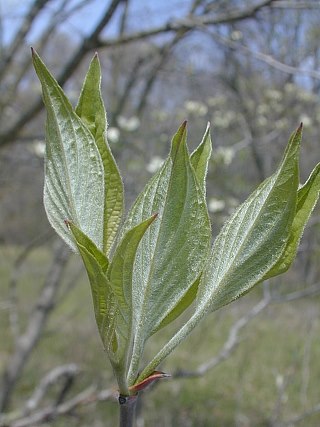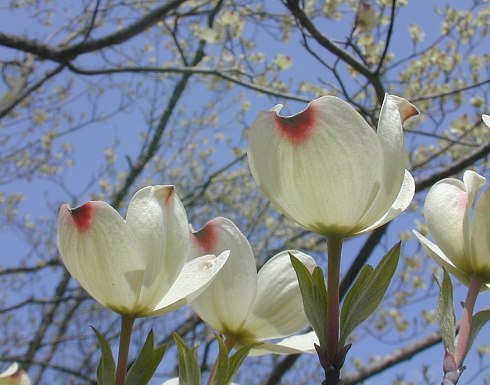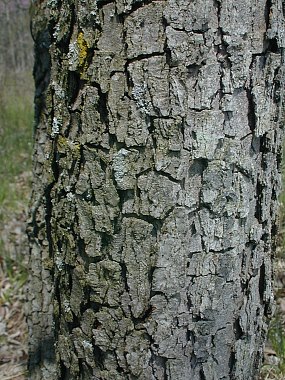Description: This shrub or tree is about 10-30' tall with ascending to spreading branches and a somewhat irregular crown. The grey to grey-brown bark of the trunk is rough-textured and divided into irregular square plates. The branches are smooth-textured with scattered round lenticels (air pores). The opposite leaves are up to 5" long and 2½" across; they are ovate or ovate-elliptic in shape and smooth along their margins. The upper sides of the leaves are medium to dark green and hairless, while their lower sides are light green with fine silky hairs (at least along the veins, if not in-between). Each leaf has 4-6 lateral veins on each side of the central vein; these veins gradually curve inward toward the tip of the leaf.

Tight clusters of yellowish green flowers are produced from the tips of young branchlets during mid- to late spring. Each flower cluster is surrounded by 4 petaloid bracts (petal-like modified leaves). The typical flower cluster and its petaloid bracts span about 4-5" across; the flower cluster in the center is no more than ¾" across. Each bract is white (sometimes tinted pink), oval to obovate in shape, and slightly notched toward its outer edge. Each flower is less than ¼" across, consisting of 4 lanceolate petals, a short-tubular calyx with 4 triangular teeth, 4 stamens, and a 2-celled ovary with a single style. While the flowers remain in bloom for only a short period of time, the petaloid bracts remain attractive for about a month. The flowers are replaced by a dense cluster of ovoid red fruits (drupes). Each fruit is about ½" long; it contains 1-2 large seeds (stones), while its flesh is thin and sour-tasting. The root system consists of a woody and branching taproot. This small tree reproduces by reseeding itself. The leaves change color to an attractive burgundy or purplish red during the fall.
Cultivation: Flowering Dogwood prefers partial shade to full sun, moist to dry-mesic conditions, and soil containing loam, clay-loam, or some rocky material. It is rather slow-growing. Unfortunately, a strain of anthracnose has been spreading around the state that can kill this beautiful small tree.

Range & Habitat: Flowering Dogwood is native to the southern half of Illinois, where it is uncommon to occasional. In the northern half of the state, it is absent, except as a cultivated landscape tree or a cultivar that has escaped (see Distribution Map). Habitats include open woodlands, woodland edges and openings, bluffs and wooded slopes, savannas, limestone or sandstone glades, and fence rows. Because of its showy floral bracts, this small tree is often planted in restorations of woodlands.
Faunal Associations: The flowers of this small tree (located between the floral bracts) attract bumblebees, cuckoo bees (Nomada), mason bees (Osmia), Halictid bees (including green metallic bees), and Andrenine bees; these bees suck nectar and/or collect pollen. Other insect visitors of the flowers include occasional wasps (suck nectar), Syrphid flies and bee flies (Bombylius), adult metallic wood-boring beetles (Buprestidae), adult long-horned beetles (Cerambycidae), and other beetles. The flies and beetles suck nectar or feed on pollen (Robertson, 1929; MacRae, 1991; Lovell, 1915). Other insects feed on foliage, flower buds, plant sap, or bore through the wood. These insect feeders include larvae of the Flat-headed Appletree Borer (Chrysobothris femorata), a leaf beetle (Capraita circumdata) that feeds on the floral bracts of this tree, larvae of the Dogwood Club Gall Midge (Resseliella clavula), a plant bug (Plagiognathus cornicola), larvae of an oligophagous moth, the Dogwood Thyatirid (Euthyatira pudens), the Dogwood Scurfy Scale (Chionaspis corni), and larvae of a butterfly, the Spring Azure (Celastrina ladon). Flowering Dogwood is a preferred host plant of three leafhoppers (Eratoneura lata, Eratoneura bidens, and Erythroneura ontari). The Insect Table provides a more complete list of insects feeding on Flowering Dogwood and other dogwood species (Cornus spp.). Among vertebrate animals, the fruits of Flowering Dogwood are eaten by many birds, including grosbeaks, sparrows, some upland gamebirds, woodpeckers, thrushes, vireos, and a few warblers. The Bird Table provides a more complete list of these species. Mammals that feed on Flowering Dogwood include Elk and White-tailed Deer (leaves, twigs), the Eastern Cottontail Rabbit (bark, twigs, saplings), the Eastern Gray Squirrel and Fox Squirrel (fruits, seeds), and the Eastern Chipmunk (fruits, seeds); see Martin et al. (1951/1961), Schneider et al. (2006), and Haugen (1942). The Screech Owl sometimes roosts in this tree, and the Evening Bat sometimes roosts in this tree when it has small cavities or loose bark (Belthoff & Ritchison, 1990; Perry & Thill, 2008).

Photographic Location: Warbler Woods in Coles County, Illinois.
Comments: Flowering Dogwood is one of the more attractive small trees or shrubs to bloom during the spring. Because of its unique petaloid bracts, there is really nothing else that resembles it in natural areas of the Midwest. It also differs from other dogwoods in the area by its shiny red fruit and the alligator-hide patterning of its trunk bark. Widely grown cultivars of Flowering Dogwood are similar to the trees in the wild – they tend to differ by having petaloid bracts that are wider and showier than those of the wild trees. Also, some cultivars have pink bracts or variegated leaves.